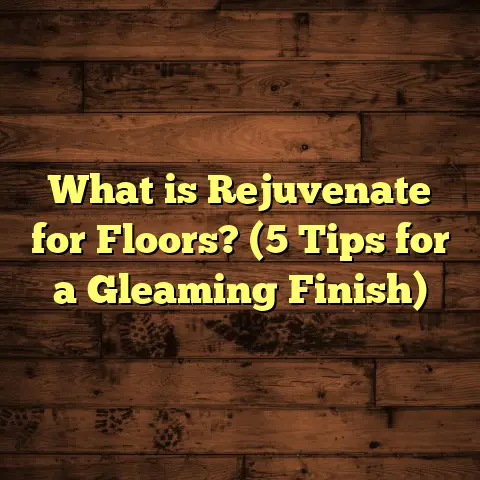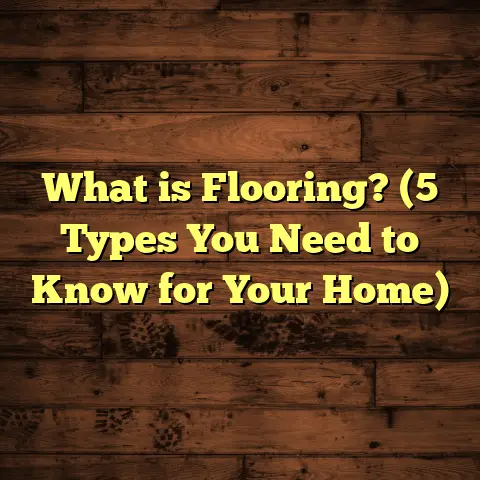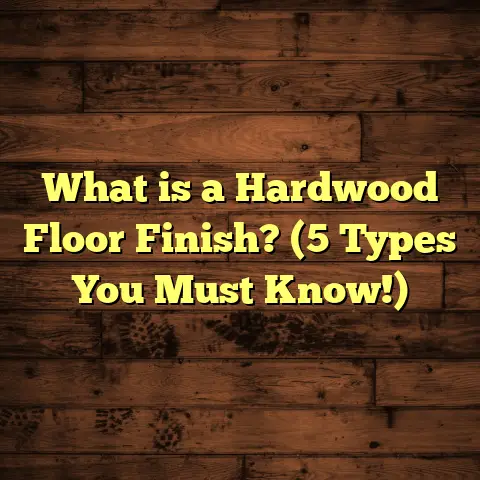What is the Rate for Vinyl Flooring Install? (5 Key Factors to Know)
Blending different flooring styles in a home is an art form I’ve truly come to appreciate over the years. It’s incredible how the right combination of materials can completely change the mood and feel of a space. I remember working with a client who wanted a rustic, farmhouse vibe in their kitchen but a sleek, modern look in the adjoining dining room. We ended up blending vinyl planks in the kitchen area with polished concrete in the dining room, and the transition was seamless and beautiful. But it got me thinking: before you start mixing and matching flooring types, you need to be clear on costs — especially for vinyl flooring, which has become increasingly popular due to its affordability, durability, and style options.
So today, let’s chat about something many homeowners ask me: What is the rate for vinyl flooring install? I’ll walk you through everything you need to know, from types of vinyl and regional labor rates to installation challenges and maintenance tips. I’ll also share some personal stories from the field alongside data-backed insights to give you a well-rounded picture. If you’re considering vinyl flooring for your home or project, this should help you budget smartly and avoid surprises.
What is the Rate for Vinyl Flooring Installation?
At its core, the rate for vinyl flooring installation refers to the total cost per square foot (or per square meter, depending on where you live) to have vinyl floors professionally installed in your space. This rate usually includes labor, materials, and sometimes additional costs like old floor removal or subfloor preparation.
Vinyl flooring comes in three main forms:
- Sheet vinyl (large rolls)
- Luxury Vinyl Plank (LVP)
- Vinyl Tiles
Each form has its own installation method and cost implications.
To give you a quick snapshot, the average total installation cost (materials + labor) typically falls between $2 to $7 per square foot, but this range can shift based on several important factors we’ll cover.
Why Vinyl Flooring?
Before jumping into costs, here’s why vinyl flooring has become such a household favorite:
- Cost-effectiveness: Vinyl is one of the most affordable flooring options.
- Durability: It’s resistant to water, scratches, and stains.
- Variety: You can find vinyl that mimics hardwood, stone, tile, or even abstract patterns.
- Ease of installation: Particularly with click-lock LVP systems.
- Comfort: It’s softer underfoot than tile or hardwood.
1. Type of Vinyl Flooring: Impact on Installation Rates
Not all vinyl floors are created equal. The type you choose dramatically affects your price tag.
Sheet Vinyl
Sheet vinyl comes in large rolls often 6 to 12 feet wide. Because it’s one continuous piece, it has fewer seams than tiles or planks. This can make installation faster but requires precise cutting to fit rooms perfectly.
- Material Cost: Generally between $0.70 to $2 per square foot.
- Installation Cost: Around $1.50 to $4 per square foot.
Installation notes: Sheet vinyl is typically glued down or sometimes loose laid with adhesive strips. Gluing provides better durability but takes longer.
My take: I’ve worked on several projects using sheet vinyl in basements or laundry rooms where moisture resistance is critical. The install time is quick if the floor is flat and prepped well. But if you have lots of corners or irregular shapes, expect labor costs to creep up.
Luxury Vinyl Plank (LVP)
LVP is designed to look just like hardwood planks but with vinyl’s durability benefits. It’s typically installed via a floating click-lock system that doesn’t require glue.
- Material Cost: From $2 to $5 per square foot.
- Installation Cost: Usually $2 to $7 per square foot.
Installation notes: LVP installation can be DIY-friendly but achieving a perfect finish requires skill, especially around doorways and transitions.
Personal story: I once installed LVP in a vacation rental where guests tracked in sand daily. The vinyl planks held up beautifully, and the client loved how easy it was to clean compared to hardwood.
Vinyl Tiles
Vinyl tiles come as individual squares or rectangles that are glued down one by one.
- Material Cost: Typically $1.50 to $3 per square foot.
- Installation Cost: Roughly $2 to $6 per square foot.
Installation notes: This is the most labor-intensive method because each tile needs precise placement and sometimes grout, which adds time and cost.
2. Size and Condition of the Installation Area
The size of your project directly affects pricing but not always proportionally.
- Larger areas often get better per-square-foot rates because installers can work continuously without stopping.
- Smaller jobs sometimes have higher rates because fixed costs (travel time, setup) don’t scale down as easily.
For example, I handled a 1,200-square-foot commercial space last year where the client got a rate near $3 per square foot for LVP installation — quite reasonable given the size.
Subfloor condition matters too.
If your existing floor needs removal or repair, expect extra charges:
| Task | Average Cost (per sq ft) |
|---|---|
| Old floor removal | $0.50 – $2 |
| Subfloor leveling/repair | $1 – $3 |
I recall a kitchen renovation where the subfloor had water damage from a leak. Fixing it before laying vinyl added several hundred dollars but saved headaches down the road.
3. Labor Costs by Location
Labor rates for flooring installation vary widely by region due to differences in living costs and demand.
Here’s an approximate labor cost breakdown per square foot in major U.S. cities (based on recent surveys):
| City | Labor Cost Range ($/sq ft) |
|---|---|
| New York City | $4 – $7 |
| Los Angeles | $3 – $6 |
| Chicago | $2.50 – $5 |
| Dallas | $2 – $4 |
| Rural Areas | $1.50 – $3 |
If you live in a high-demand urban area, expect prices toward the upper end of these ranges.
4. Complexity of Installation
Not every room is straightforward. Here are some factors that can add complexity:
- Floor shape: Odd angles or many corners increase cutting time.
- Subfloor type: Concrete may require moisture barriers; wood might need sanding or leveling.
- Existing floor removal: Removing tile or hardwood adds labor.
- Transitions: Moving from vinyl to carpet or tile requires careful molding installation.
I once installed vinyl planks in a home with several small rooms connected by narrow hallways. The cuts were so precise that it felt like laying a puzzle — it took almost twice as long as a simple rectangular room.
5. Additional Materials & Features
Beyond just flooring and labor, other materials can add to your budget:
- Underlayment: Adds comfort and soundproofing; costs roughly $0.50–$1 per sq ft.
- Adhesives/Sealants: Needed for sheet vinyl or tiles.
- Trims & Moldings: Finish edges; around $1 per linear foot.
- Waste Factor: Typically 5–10% extra material ordered for cuts/mistakes.
In one project, a client chose an upgraded underlayment for better sound insulation between floors in an apartment complex. The extra $800 spent was well worth it for tenant satisfaction.
Breaking Down Costs — A Real Case Study
Let me share a detailed example from my own experience:
The Johnson Family Kitchen & Living Room Project
- Area: 600 sq ft (kitchen + living room open concept)
- Vinyl type: Mid-range Luxury Vinyl Plank
- Existing floor: Carpet (required removal)
- Subfloor: Wood with minor unevenness
Cost Breakdown:
| Item | Unit Cost | Total |
|---|---|---|
| LVP Material | $3.50/sq ft | $2,100 |
| Carpet Removal | $1/sq ft | $600 |
| Subfloor Repair | $1.50/sq ft | $900 |
| Labor Installation | $4/sq ft | $2,400 |
| Underlayment | $0.75/sq ft | $450 |
| Moldings & Trim | $1/linear ft (100 ft) | $100 |
| Waste Factor (8%) | Included in material | N/A |
Total Cost: Approximately $6,550
The Johnsons were happy with this price because it included everything from removal to finish work. Their new floors looked great and held up well over time.
Maintenance Tips To Maximize Your Investment
Vinyl flooring is easy to care for, which is one reason I recommend it so often.
Here’s what I tell clients:
- Sweep or vacuum regularly to remove grit.
- Mop with mild soap or cleaner designed for vinyl floors.
- Avoid abrasive cleaners or scrubbing pads that can scratch surfaces.
- Use protective pads under furniture legs.
- Wipe spills promptly to prevent stains or water damage.
- Keep pet nails trimmed to avoid scratches.
With proper care, vinyl floors can last anywhere from 10 to 20 years depending on foot traffic and environment.
Comparing Vinyl Installation Costs With Other Flooring Types
To put things in perspective, here’s how vinyl installation stacks up against other common options:
| Flooring Type | Average Total Cost ($/sq ft) | Durability & Maintenance Notes |
|---|---|---|
| Vinyl (LVP) | $3 – $7 | Water-resistant, easy maintenance |
| Hardwood | $8 – $15 | Durable but requires refinishing over time |
| Laminate | $4 – $8 | Scratch-resistant but can swell with water |
| Tile | $7 – $15 | Very durable but cold and harder underfoot |
| Carpet | $3 – $6 | Soft but stains easily and needs regular cleaning |
Vinyl often wins out on price plus water resistance—perfect for kitchens, bathrooms, basements, or high traffic areas.
How To Get Accurate Vinyl Flooring Installation Estimates
If you want precise numbers tailored to your project:
- Measure your total floor area carefully.
- Identify the type of vinyl you want.
- Consider any prep work needed (removal/repairs).
- Factor in your location’s labor rates.
- Use online tools like FloorTally that combine material + labor + waste factors instantly.
I’ve found FloorTally particularly helpful because it saves hours of calling around for quotes and gives realistic budgets based on your zip code and material choices.
My Personal Tips for Hiring Installers
Since installation quality affects how your floors look and last:
- Ask for references and examples of past work.
- Verify if they handle subfloor prep and old floor removal.
- Get detailed quotes listing all costs (materials, labor, extras).
- Confirm warranty terms for both product and installation.
- Avoid super-low bids that seem too good to be true—quality work has value.
Common Vinyl Installation Issues & How To Avoid Them
From experience, here are some issues homeowners run into:
Gaps Between Planks or Tiles
Usually caused by uneven subfloors or rushed installation. Proper floor prep is key.
Peeling Edges or Lifting Corners
Often due to poor adhesive application or moisture under the floor—moisture testing helps prevent this.
Visible Seams
Sheet vinyl may show seams if cuts aren’t precise; professional installers minimize this problem.
Wrapping Up My Thoughts on Vinyl Flooring Rates
Vinyl flooring remains an excellent option for many budgets and lifestyles thanks to its versatility and affordability. But knowing what influences installation rates helps you plan better and get what you pay for.
The key factors I’d want you to remember:
- Type of vinyl affects both material and labor costs.
- Size and condition of your floor change preparation needs.
- Labor rates vary widely by location.
- Complexity adds time — expect higher costs in odd-shaped rooms or damaged floors.
- Extras like underlayment and trims add comfort but also cost more upfront.
If you’re ready to explore vinyl options or want help figuring out installation estimates for your project, reach out! It’s always worth chatting through specifics because every home is unique.
Have you tried mixing vinyl flooring with other types? Maybe combining it with hardwood in living areas or tile in bathrooms? It’s easier than you think—and really brings personality into your home design.
Got questions about what fits your budget? Curious about the best products available right now? I’m happy to share what I’ve learned from hundreds of installs over the years—just ask!





